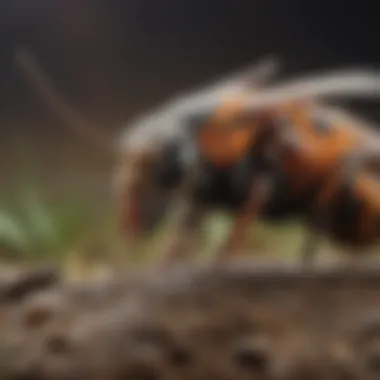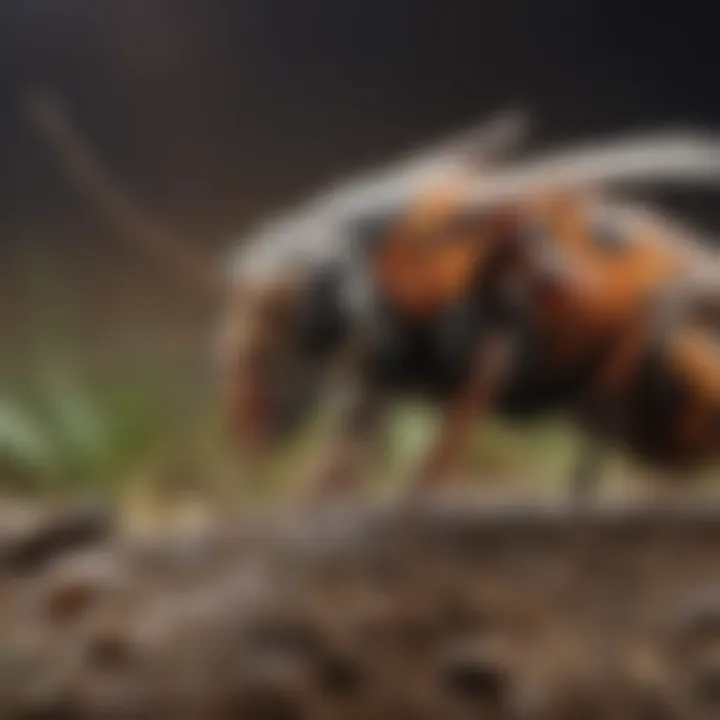Piper Pest Control: Effective Management Strategies


Intro
In the realm of pest management, sustainable approaches are gaining traction as society increasingly seeks solutions that align with ecological principles. Among these methods, piper pest control stands out. It involves the use of piper plants and their derivatives to effectively manage pest issues while considering environmental impact.
This article explores the intricate biology of piper species, their mechanisms of action against pests, and the benefits of integrating these plants into pest management strategies. Readers will find insights that marry historical practice with modern applications, ensuring a thorough understanding of both the advantages and considerations that come with piper pest control.
Understanding Pests
Definition of Pests
Pests can be classified as organisms that negatively affect human activities, either by damaging crops, spreading diseases, or causing discomfort. This group includes insects, rodents, and even some plants that compete with desired species. The designation of "pest" is context-dependent; something beneficial may become harmful under certain conditions.
Importance of Pest Identification
Identifying pests accurately is crucial for effective management. Misidentification can lead to inappropriate control measures, resulting in wasted resources and potential harm to beneficial species. For effective pest control, proper identification allows for tailored strategies that target specific pests.
Prevention Techniques
Home and Garden Preventative Measures
Preventative measures are essential in reducing the occurrence of pests. Here are some strategies:
- Seal Entry Points: Ensure that windows and doors are properly sealed to prevent access.
- Maintain Cleanliness: Regularly remove food scraps and clutter that can attract pests.
- Employ Biological Barriers: Use nets or row covers in gardens to keep pests at bay.
Seasonal Prevention Tips
Pests tend to fluctuate with the seasons. Understanding their life cycles can help in preventive efforts. For instance:
- Spring: Inspect and treat for early infestations before they proliferate.
- Summer: Monitor garden health and employ mulching to deter pests.
- Fall: Prepare your home for winter by cleaning attics and sealing potential entry points.
Eco-Friendly Pest Control Solutions
Overview of Sustainable Practices
Sustainable pest control methods prioritize environmental health. This includes using organic materials, encouraging beneficial insects, and relying on natural predators to manage pest populations. Such approaches not only alleviate pest issues but also promote a balanced ecosystem.
Natural Remedies and Their Effectiveness
Natural remedies have gained popularity as alternatives to chemical pesticides. Some effective solutions include:
- Neem Oil: Known for its ability to disrupt pest life cycles.
- Diatomaceous Earth: A natural abrasive that can deter insects when applied to infested areas.
- Insecticidal Soaps: These can effectively control soft-bodied insects without harming beneficial ones.
"Integrating piper plants into pest management strategies provides an innovative way to combine traditional wisdom with modern science."
Ultimately, effective pest management involves a comprehensive understanding of pest biology, proactive prevention strategies, and eco-friendly solutions. As home and property owners delve into piper pest control, the potential for sustainable pest management becomes increasingly tangible.
Preamble to Piper Pest Control
Piper pest control is an innovative area within pest management, focusing on the application of natural substances derived from piper plants. Understanding how these plants function to combat pests is crucial for sustainable horticulture and landscape management. This approach not only minimizes environmental impact but also aligns with current trends toward eco-friendly solutions. An informed exploration of piper pest control can reveal a wealth of knowledge, promoting better practices for household and community pest management.
Definition of Piper Pest Control
Piper pest control refers to the use of various species of piper plants and their extracts as a means of managing pest populations. This can involve using the essential oils, powdered forms, or even infusions of these plants, each chosen for its specific repellent or insecticidal properties. The most notable species used include Piper nigrum, commonly known as black pepper, and Piper methysticum, known as kava. These plants contain compounds that can disrupt pest life cycles or deter them from invading cultivated areas.
Significance in Pest Management
The significance of piper in pest management cannot be understated. First, this method presents a more sustainable approach compared to synthetic pesticides. Traditional pest control methods often rely heavily on chemical agents that can negatively affect the ecosystem. In contrast, piper-based strategies can be less harmful to non-target species, thus preserving the ecological balance. Furthermore, piper pest control is often cost-effective, suitable for household use, and easy to implement. Homeowners can apply these natural solutions without requiring extensive training or resources.
Moreover, adopting piper pest control strategies aligns with the increasing consumer demand for organic and natural products. With the global push toward sustainability, utilizing piper plants contributes positively to both the environment and public health. This interest serves to motivate ongoing research into piper’s efficacy, leading to more refined and effective pest management techniques.
"Natural solutions, like those provided by piper plants, signify a return to traditional methods that respect the balance of nature in pest management."
Ultimately, the exploration of piper pest control provides insights not just into pest management efficacy but also toward broader sustainable practices in agriculture and horticulture.


Overview of Piper Plants
Piper plants are notable for their diverse uses, especially in pest control applications. Understanding their various characteristics and common varieties is critical, as they offer both unique benefits and special considerations in the context of integrated pest management. This section highlights their importance, examining how these plants can provide sustainable solutions for managing pest populations, ultimately enhancing ecological balance in agricultural and residential settings.
Botanical Characteristics
Piper plants belong to the family Piperaceae, which mainly features herbs and shrubs. The most recognized genus is Piper, which includes over 1,000 species. These plants generally exhibit a range of heights, from low-growing herbs to larger shrubs. Their leaves are simple, often heart-shaped, with a glossy appearance that can vary in size. The plants also produce inconspicuous flowers that sit atop elongated spadices, eventually yielding small berries. The presence of various alkaloids like piperine in some species contributes to their pest-repellent properties.
These botanical attributes enhance their role in pest management. For example, the essential oils extracted from piper plants are potent against a spectrum of household and agricultural pests, providing an effective alternative to synthetic pesticides. Furthermore, the distinct aromatic compounds released through their foliage help in creating a natural barrier against insects, making them appealing for sustainable agricultural practices.
Common Varieties Used in Pest Control
Several piper plant varieties are prominent in pest control. Among them:
- Piper nigrum: Commonly known as black pepper, this variety is famous for its culinary use, but it also serves as a natural insect repellent. Its extracts can deter a range of pests such as cockroaches and ants.
- Piper longum: This plant is less commonly known but has shown effectiveness against various insect pests. Its essential oils may be used in formulations intended for household use.
- Piper cubeba: Known as cubeb pepper, this species has been studied for its insecticidal properties. It is particularly useful in managing specific mosquito populations that are vectors for diseases.
- Piper betle: Often used in traditional medicine, this variety may also possess pest deterrent qualities. Studies suggest that its essential oils can repel certain beetles and flying insects.
"The incorporation of piper plants in pest management practices not only provides an eco-friendly solution but also enhances biodiversity within the ecosystem."
Merging these species into existing pest control strategies can lead to innovative methods, reducing the reliance on chemical pesticides. As practitioners learn more about the specific properties of these piper varieties, successful pest management approaches become feasible, ensuring healthier living environments for homeowners.
Mechanisms of Action
Understanding the mechanisms of action of piper pest control is essential for effective pest management. This involves comprehending how piper plants interact with pests, leading to beneficial outcomes for household and garden settings. Utilizing the natural properties of piper species enhances pest control measures while minimizing harm to the environment. Effective application of these mechanisms can ensure a safer living space for families by addressing common pest issues without relying solely on synthetic chemicals.
Natural Insecticidal Properties
Piper plants, particularly those in the Piperaceae family, exhibit notable insecticidal properties. The active compounds found within these plants, such as piperine, play a crucial role in disrupting the biological processes of pests. Piperine interferes with the pest's nervous system, leading to paralysis and eventual mortality. This natural insecticidal characteristic is beneficial for homeowners who prefer eco-friendly solutions.
Additionally, studies have shown that piper extracts can reduce the reproductive success of various pest species. This means that even if some insects survive an application, their ability to reproduce is significantly hampered. As a result, populations decrease over time, providing a long-term pest management solution.
Repellent Effects
In addition to their insecticidal action, piper plants possess remarkable repellent effects. The aroma and chemical composition of piperine and related compounds can deter pests such as mosquitoes, flies, and ants. When forage for food or habitat, many insects shy away from areas treated with piper extracts. This attribute is particularly useful for home gardens and outdoor living spaces where uninvited guests can disrupt leisure activities.
Thus, incorporating piper pest control methods not only tackles existing pest issues but also acts as a preventive measure. The dual functionality of piper compounds emphasizes the effectiveness of this pest management strategy, appealing to individuals looking for holistic and sustainable options.
"Using piper pest control combines pest elimination with prevention, making it a preferred choice for many homeowners."
In summary, the mechanisms of action of piper pest control are twofold: they provide natural insecticidal properties while simultaneously acting as effective repellents. Embracing these mechanisms allows home and garden caretakers to create a healthier living environment free from common pests.
Piper Pest Control in Practice
The application of piper plants in pest control is not just innovative; it represents a shift towards using natural solutions in managing infestations. This section emphasizes practical strategies and the effective implementation of piper pest control methods. Using piper plants significantly highlights their versatility and accessibility, contributing to sustainable pest management practices suitable for both home users and professional applicators.
Application Methods
Each application method plays a crucial role in enhancing the effectiveness of piper pest control. These methods highlight how piper derivatives can be utilized in various formats to address pest concerns effectively.
Infusions
Infusions are one effective way to extract the pest-repellent qualities of piper plants. This method involves steeping piper leaves in water, allowing vital compounds to dissolve and create a liquid solution. The key characteristic of infusions is their ease of preparation. This simplicity makes infusions a popular choice for homeowners who prefer a quick and straightforward method of pest management.
A unique feature of infusions is that they can be applied directly to affected areas, making them a practical solution for indoor pest control. They carry the advantage of being nontoxic to humans and pets when prepared correctly. However, a disadvantage could be the short shelf-life of the infusion, requiring frequent preparation for lasting effects.
Essential Oils
Essential oils extracted from piper plants offer concentrated forms of their pest-repellent properties. The specific aspect of essential oils is their strength and effectiveness against a variety of pests. This makes them a powerful option in pest control strategies.
The key characteristic of essential oils is their potent aroma. Many pests are repelled by strong scents, making essential oils a favorable choice for those seeking natural deterrents. A unique feature of essential oils is their versatility; they can be diffused in living spaces or diluted for direct application.
However, essential oils also present disadvantages, such as the potential for skin irritation in sensitive individuals and the need for proper dilution to ensure safety and effectiveness.
Powdered Formulations


Powdered formulations of piper plants represent another practical method of pest control. This involves grinding dried piper materials into a fine powder. The specific aspect of powdered formulations is their durability and ease of storage. Homeowners find these formulations beneficial as they can be kept for extended periods without losing potency.
The key characteristic of powdered formulations is their application method. They can be dusted onto affected plants or locations, creating a barrier against pests. A unique feature is their ability to be mixed into soil for long-term effectiveness.
Nevertheless, one downside is that powdered formulations can create messes and may require careful handling to avoid respiratory irritation, highlighting the importance of using protective measures during application.
Target Pests
Piper pest control methods target a wide range of pests, including but not limited to aphids, spider mites, and whiteflies. Relevant research has shown that piper derivatives have shown efficacy in deterring these common household pests. The natural composition of these plants presents an attractive alternative to synthetic pesticides, aligning with increasing trends in eco-friendly pest management.
As we consider the vast potential of piper pest control, we must acknowledge the practical applications and target pests. Each method presents unique advantages and challenges that users need to navigate in their pest management efforts, reinforcing the importance of informed, strategic use of piper in practices.
Integrated Pest Management Strategies
Integrated Pest Management (IPM) is crucial in the context of piper pest control because it emphasizes a holistic approach to managing pest populations. This method combines several strategies to minimize pest damage while considering environmental impact. The benefits of IPM are noteworthy; it reduces reliance on chemical pesticides, promotes biodiversity, and often results in cost savings over time. Understanding how piper plants fit into this broad strategy allows for a more sustainable pest control approach.
Combining Piper with Other Methods
Cultural Practices
Cultural practices refer to the modifications of farming or gardening practices that help deter pests. This includes crop rotation, selecting pest-resistant plant varieties, and maintaining optimal growing conditions. The key characteristic of cultural practices is their preventative focus—rather than addressing pest problems after they occur, these practices aim to prevent pests from becoming a problem in the first place.
Cultural practices are beneficial in the context of piper pest control because they enhance the effectiveness of piper’s natural properties. For instance, rotating crops with piper species can lower pest populations in subsequent plantings. However, the unique feature of cultural practices lies in their variability; effectiveness can differ based on local conditions and pest types. Their advantages include sustainability and reduced need for chemical inputs, while potential disadvantages consist of the requirement for more detailed management and knowledge of local ecosystems.
Biological Control
Biological control involves using natural predators or parasites to manage pest populations. This strategy highlights the interconnectedness of ecosystems by promoting beneficial organisms that can suppress pest numbers. The key characteristic of biological control is its alignment with natural processes, leading to a more ecological form of pest management.
Using piper in biological control can be advantageous because some piper species can attract beneficial insects such as predatory beetles or parasitoids. This can create a balanced ecosystem where pests are naturally managed without the need for synthetic chemicals. However, biological control can also have its drawbacks, such as the time it takes to establish effective natural populations and the potential for unintended consequences in the ecosystem if not well-managed.
Chemical Control
Chemical control, the application of pesticides, plays a role in integrated pest management but must be used judiciously. The key characteristic of chemical control is its immediate action against pests, which can be a necessary part of pest management during severe infestations.
Incorporating piper pest control as a part of chemical strategies is beneficial because piper extracts can serve as less harmful alternatives to conventional pesticides. The unique feature of this approach lies in its potential to reduce chemical residues in the environment and promote public health. Yet, the disadvantages include the potential development of pest resistance and adverse environmental impacts, stressing the importance of responsible use alongside other methods.
Case Studies
In this section, we will explore specific instances where piper pest control has been integrated into pest management strategies. These case studies highlight successful applications and provide insights into the practical value of using piper in diverse settings.
Through examining real-world examples, we can better appreciate the benefits and challenges of implementing integrated pest management strategies alongside the unique properties of piper plants.
Environmental Considerations
Piper pest control offers numerous environmental benefits, making it a compelling choice for both homeowners and pest management professionals. By using piper plants as a pest management method, we gain not only an effective solution but also a sustainable approach that minimizes ecological disruption. Understanding the environmental considerations surrounding this practice is essential. It helps in devising strategies that align with sustainable agriculture and foster healthier ecosystems.
Sustainability of Piper Pest Control
Sustainability in pest management is an increasingly crucial topic. Piper pest control supports sustainability in several ways. First, piper plants typically grow in diverse environments. This characteristic can lead to local sourcing, which reduces transportation impacts on the environment. Moreover, piper plants may require less water and fewer resources compared to conventional chemical pesticides.
Continuing, these plants often contribute to biodiversity. Integrating piper into pest management allows for a multi-faceted approach to maintaining a healthy garden or landscape. It encourages the presence of beneficial insects and other organisms that contribute to an ecological balance. When implemented correctly, the use of piper can help create a more resilient ecosystem, reducing dependency on synthetic chemicals.
In contrast to chemical pesticides, which often lead to pest resistance and additional environmental issues, piper-based methods tend to be less disruptive. This alignment with sustainable practices not only benefits the environment but also enhances soil health, promoting a flourishing habitat for plants and wildlife alike.
Impact on Non-target Species
When employing any pest control strategy, it is vital to consider its impact on non-target species. Piper pest control is generally viewed as less harmful to non-target organisms. Piper plants can attract beneficial insects, like pollinators, which are critical for maintaining flower and fruit production in gardens and crops. The natural compounds found in these plants usually target specific pests, which helps minimize unintended consequences.
However, it is essential to remain cautious. While piper’s effects can be targeted, there exists a possibility of inadvertently affecting certain non-target species. Research into these impacts remains crucial as stewards of the environment. Observing the health of non-target species in environments where piper is employed can yield valuable data on its ecological impact. Understanding these interactions ensures the responsible use of piper as a pest control measure.
"Effective pest management not only deals with current pest populations but also promotes long-term ecological balance."
Overall, integrating piper plants into pest control approaches aligns well with modern environmental standards. It encourages a thoughtful examination of ecological relationships and empowers homeowners to cultivate gardens that are both beautiful and sustainable.


Historical Context
Understanding the historical context of piper pest control provides valuable insights into its significance in today's pest management strategies. The use of piper plants can be traced back to ancient civilizations that recognized the potential of these plants in protecting crops and homes from pests. By examining traditional applications, we can appreciate how indigenous knowledge and practices shaped current methodologies in pest control.
Traditional Uses of Piper
Historically, piper species such as Piper nigrum (black pepper) and Piper betle (betel leaf) have been utilized in various cultures for their pest-repellent properties. Many cultures deployed these plants not just as culinary spices but also as natural repellents against insects like mosquitoes and crop pests. In rural communities, leaves and extracts were often used in homemade preparations to ward off unwanted pests in agricultural settings.
In addition to their repellent qualities, piper plants have been employed in traditional medicine. The active compounds in piper, such as piperine, have shown antimicrobial and insecticidal properties. This multifaceted use underscores their importance in sustainable pest control practices. The integration of these plants into local ecosystems demonstrates a long-standing relationship between humans and their environment, whereby biological pest control methods were favored over synthetic chemicals.
Evolution of Pest Management Techniques
As pest management techniques have evolved, the historical context provides a foundation for contemporary practices. Initially, pest control relied heavily on localized knowledge, with farmers using rudimentary methods to protect their crops. Over time, as awareness of the adverse effects of chemical pesticides grew, there was a shift towards more integrated and organic approaches. The role of piper plants gained renewed interest as researchers sought sustainable solutions to pest management challenges.
Today, piper pest control forms part of an integrated pest management (IPM) strategy, combining traditional knowledge with scientific research. The resurgence of interest in natural solutions, spurred by environmental concerns, mirrors historical applications of piper plants. Innovations in extraction and application methods have further facilitated their effectiveness in various settings.
Moreover, this evolution has been supported by studies emphasizing the ecological benefits of using natural repellents. Unlike synthetic pesticides, piper derivatives often pose fewer risks to non-target species and the environment. This historical progression illustrates an ongoing cycle of adapting and incorporating ancient wisdom into modern practices.
Challenges and Limitations
Understanding the challenges and limitations of piper pest control is essential for anyone looking to implement these strategies effectively. While using piper plants in pest management offers numerous benefits, there are also factors that can hinder their effectiveness. Recognizing these challenges can help users adapt their methods, ensuring a more successful application of piper pest control in various settings.
Efficacy Under Different Conditions
The efficacy of piper pest control can vary significantly depending on environmental factors. Different climates, soil types, and pest populations affect how well piper plants work.
- Climatic Influence: For example, piper species, such as Piper nigrum, thrive in tropical conditions. In contrast, their effectiveness in arid climates remains questionable.
- Soil Composition: The soil quality and pH of an area can influence the concentration of bioactive compounds in piper plants, impacting their pest-repelling capabilities.
- Pest Resistance: Some pests may develop resistance to compounds found in piper plants, undermining their effectiveness. Regular monitoring and adaptation of strategies are necessary to address these issues.
Regulatory Factors
The regulatory landscape surrounding pest management can pose significant limitations to the use of piper pest control. Government regulations play a pivotal role in determining which substances can be used and how they can be applied.
- Approval Processes: Many regions require extensive testing and approval before piper-based formulations can be marketed. This can lead to delays in availability and increased costs.
- Labeling and Usage Guidelines: It is essential for users to adhere to specific labeling guidelines provided by regulatory agencies. Non-compliance can result in legal consequences and environmental damage.
- Restrictions on Application: In some areas, there may be restrictions on the use of certain piper extracts near water sources or sensitive habitats, limiting where and how these products can be utilized.
In summary, while piper pest control offers valuable options in managing pest populations, it also presents distinct challenges that require consideration. Factors such as environmental conditions and regulatory hurdles can affect the effectiveness and availability of these strategies. Users must be aware of these limitations to optimize their pest management endeavors.
Future Directions
The direction of research and application in piper pest control is vital. It aids in broadening our understanding of how these plants can be used effectively against pests. By analyzing current trends and exploring untapped avenues, we can ensure that pest control strategies remain relevant and effective in an ever-changing environment.
Research Opportunities
Research opportunities in piper pest control can focus on several areas:
- Efficacy Studies: Investigating the effectiveness of different piper extracts on a wide variety of pests can provide insights into which formulations yield the best results.
- Bioactive Compounds: Identifying and examining the specific bioactive compounds in piper species will enhance our understanding of their mechanisms of action.
- Field Trials: Conducting field trials under various environmental conditions can help determine the practical applicability and limitations of piper pest management.
- Consumer Acceptance: Studying the perceptions and acceptance of piper-based products among housewives and homeowners will inform marketing strategies and product development.
These areas not only contribute to the body of knowledge but also support the development of more effective, sustainable pest management solutions.
Innovative Applications of Piper
The innovative applications of piper plants in pest control are diverse and promising.
- Natural Pesticide Formulations: By developing natural pesticide products, we can offer eco-friendly alternatives to chemical pesticides that are often harmful to the environment.
- Home Gardening Solutions: Homeowners can utilize piper extracts in their gardens to protect vegetables and ornamental plants from pests without resorting to harmful chemicals.
- Integration with Technology: Utilizing technology such as smart application systems can ensure that piper-based treatments are applied efficiently, maximizing their effectiveness.
- Educational Programs: Conducting workshops and seminars to educate the target audience about the benefits and application methods of piper can increase awareness and promote its use in pest management.
"Innovative approaches in utilizing piper pest control can lead to significant advancements in sustainable practices and consumer safety."
These innovative applications not only take advantage of piper's natural properties but also align with a growing demand for sustainability in pest management.
The End
The importance of the conclusion in this article cannot be overstated. It serves as a vital summary that encapsulates the key insights discussed throughout the various sections on piper pest control. Understanding the essence of piper plants in pest management highlights their potential benefits, which include sustainability and integrated pest management. Moreover, considerations surrounding their use prompt homeowners and housewives to reflect on environmentally conscious practices that can be adopted in everyday life.
Summary of Findings
The exploration into piper pest control reveals several crucial factors. Firstly, the botanical characteristics of piper plants contribute to their effectiveness in pest management. The natural insecticidal properties and repellent effects are significant tools in combating various pests. Furthermore, integrating piper with other management strategies presents a holistic approach, allowing for effective pest control. The historical context shows how traditional methods evolve into modern applications, making piper relevant today.
Additionally, challenges such as regulatory factors and efficacy under different environmental conditions must be acknowledged. By highlighting these aspects, this article provides a balanced view of the potential and limitations of piper pest control. It encourages readers to evaluate how these findings can apply to their own pest management situations.
Final Thoughts on Piper Pest Control
The insights gathered herein urge the audience to experiment with different piper applications. Be it through infusions, essential oils, or powdered forms, each method holds the potential for positive outcomes. Equally important is the need for further research into innovative applications. This journey into piper pest control invites a proactive stance in pest management, merging ecological considerations with practical household solutions.



